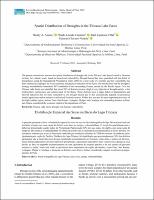Spatial Distribution of Droughts in the Titicaca Lake Basin
Metadata
Show full item recordDate
2022-09-26Subject
Titicaca Lake basin - Drought - Hazard - Sequías Meteorológicas - Evaluación de Riesgos - Precipitación - Sequías - Sequías AgrícolasCollections
Related Resource(s)
https://www.scielo.br/j/rbmet/a/tGL8jtrggjTr6nyb9v5MSJH/?lang=en#ModalDownloadsAbstract
The present research has assessed the spatial distribution of drought risk in the Titicaca Lake Basin located in Peruvian territory for a district scale, based on hazard and vulnerability. Drought hazard has been quantified with the deficit of precipitation using the Standardized Precipitation Index (SPI) for a time scale of 3-months, and the vulnerability has been obtained according to the socio-economic and physical indicators of the Basin. The results show that the drought is strongly modulated by anomalous SST conditions of the surrounding Oceans, mainly by the Pacific region. Over the Titicaca Lake Basin was identified that about 50% of districts present a high to very high risk of drought mainly, in the northwestern, central-east, and central-south of the Basin. These districts have a larger deficit of precipitation and showed indicators that are more vulnerable to the drought hazard due to that economically depends on precarious rainfed agriculture and an extensive and mixed livestock system. Within this area are the most important provinces of the high-Andean region, such as Puno, San Roman, Azángaro, Melgar, and Carabaya, and outstanding districts as Puno and Juliaca, considered the economic capital of the department of Puno.
The following license files are associated with this item:








